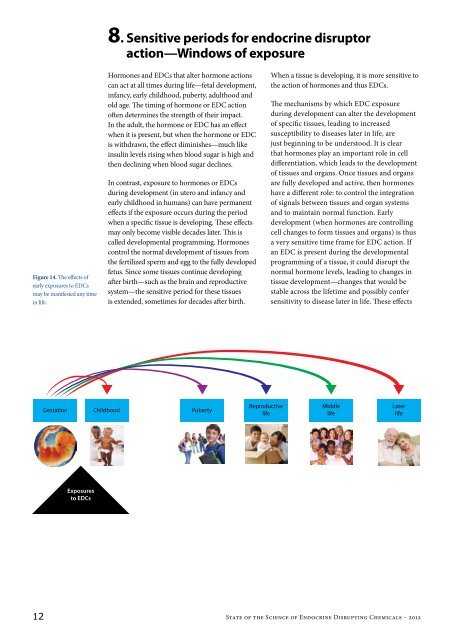Endocrine Disrupting Chemicals 2012 - World Health Organization
Endocrine Disrupting Chemicals 2012 - World Health Organization
Endocrine Disrupting Chemicals 2012 - World Health Organization
You also want an ePaper? Increase the reach of your titles
YUMPU automatically turns print PDFs into web optimized ePapers that Google loves.
8. Sensitive periods for endocrine disruptor<br />
action—Windows of exposure<br />
Figure 14. The effects of<br />
early exposures to EDCs<br />
may be manifested any time<br />
in life.<br />
Hormones and EDCs that alter hormone actions<br />
can act at all times during life—fetal development,<br />
infancy, early childhood, puberty, adulthood and<br />
old age. The timing of hormone or EDC action<br />
often determines the strength of their impact.<br />
In the adult, the hormone or EDC has an effect<br />
when it is present, but when the hormone or EDC<br />
is withdrawn, the effect diminishes—much like<br />
insulin levels rising when blood sugar is high and<br />
then declining when blood sugar declines.<br />
In contrast, exposure to hormones or EDCs<br />
during development (in utero and infancy and<br />
early childhood in humans) can have permanent<br />
effects if the exposure occurs during the period<br />
when a specific tissue is developing. These effects<br />
may only become visible decades later. This is<br />
called developmental programming. Hormones<br />
control the normal development of tissues from<br />
the fertilized sperm and egg to the fully developed<br />
fetus. Since some tissues continue developing<br />
after birth—such as the brain and reproductive<br />
system—the sensitive period for these tissues<br />
is extended, sometimes for decades after birth.<br />
Developmental Exposures to EDCs Lead to Disease Throughout Life<br />
When a tissue is developing, it is more sensitive to<br />
the action of hormones and thus EDCs.<br />
The mechanisms by which EDC exposure<br />
during development can alter the development<br />
of specific tissues, leading to increased<br />
susceptibility to diseases later in life, are<br />
just beginning to be understood. It is clear<br />
that hormones play an important role in cell<br />
differentiation, which leads to the development<br />
of tissues and organs. Once tissues and organs<br />
are fully developed and active, then hormones<br />
have a different role: to control the integration<br />
of signals between tissues and organ systems<br />
and to maintain normal function. Early<br />
development (when hormones are controlling<br />
cell changes to form tissues and organs) is thus<br />
a very sensitive time frame for EDC action. If<br />
an EDC is present during the developmental<br />
programming of a tissue, it could disrupt the<br />
normal hormone levels, leading to changes in<br />
tissue development—changes that would be<br />
stable across the lifetime and possibly confer<br />
sensitivity to disease later in life. These effects<br />
Gestation Childhood Puberty<br />
Reproductive<br />
life<br />
Middle<br />
life<br />
Later<br />
life<br />
Exposures<br />
to EDCs<br />
12 State of the Science of <strong>Endocrine</strong> <strong>Disrupting</strong> <strong>Chemicals</strong> – <strong>2012</strong>
















